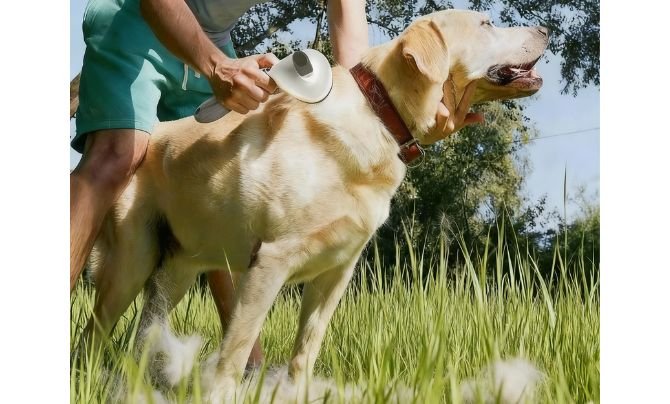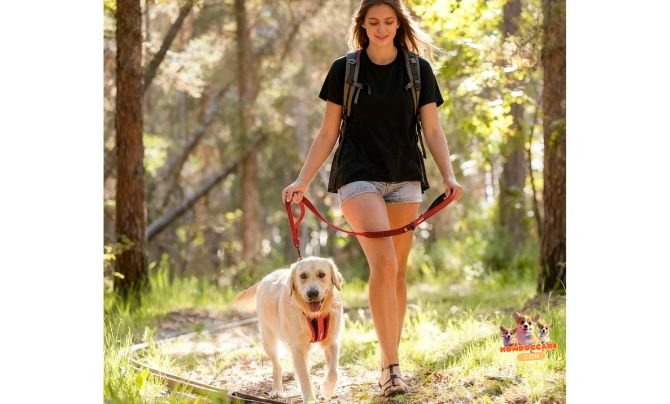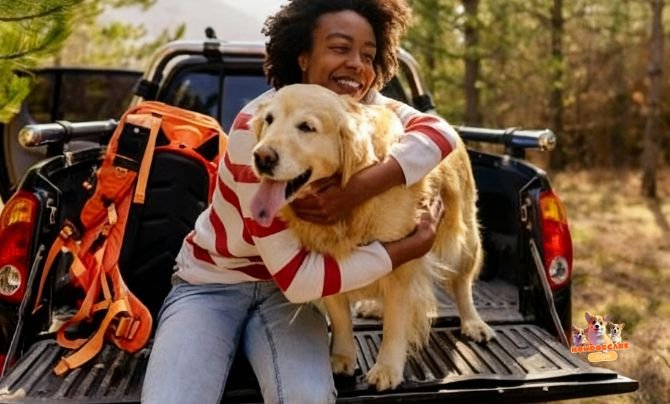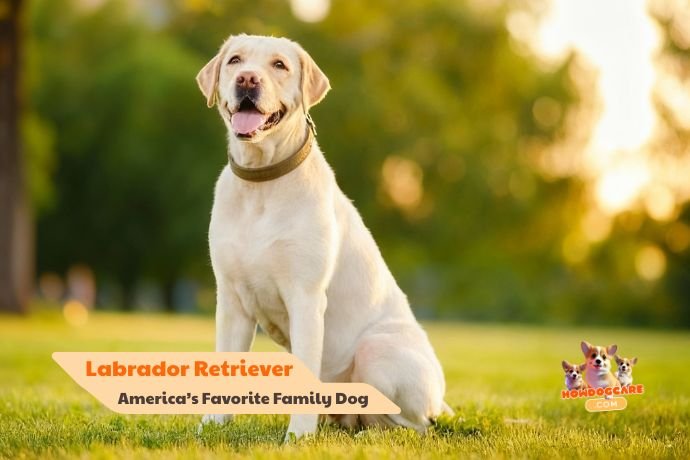When you picture the perfect family dog, chances are you’re imagining a Labrador Retriever. Friendly, playful, intelligent, and loyal—Labradors have rightfully earned their title as America’s favorite family dog. For decades, these lovable companions have graced homes, parks, and even Hollywood screens. But what makes them such beloved pets? In this detailed guide, we’ll explore everything from their history and temperament to grooming needs, nutrition, and training essentials. Whether you’re already a proud Lab parent or thinking about adding one to your family, you’ll find everything you need to know right here.
Introduction to the Labrador Retriever Breed
History and Origins of the Labrador Retriever
The Labrador Retriever may be the pride of American households today, but its roots go much deeper, tracing back to Newfoundland, Canada. Originally known as the “St. John’s Dog,” these early Labradors were used by fishermen to retrieve nets, ropes, and even fish from icy waters. Their waterproof coat, strong build, and natural swimming ability made them indispensable working dogs.
By the early 19th century, the breed caught the attention of visiting English nobles who began bringing them back to Britain. It was there that selective breeding honed the Labrador’s retrieving instincts, intelligence, and friendliness, turning them into the hunting and family dogs we know today.
Fast-forward to modern times, and Labs have become the go-to breed for families, hunters, service dog trainers, and active individuals alike. They consistently rank at the top of the American Kennel Club’s (AKC) most popular dog breeds.
Why Labs Are So Popular in America
So why do Americans love Labs so much? Their popularity stems from a combination of physical attributes and unmatched personality traits:
- Adaptability: Whether you live in a suburban home with a fenced yard or an apartment in the city, Labs can adapt as long as they get enough exercise.
- Great with children: Their playful yet gentle temperament makes them excellent companions for kids of all ages.
- Intelligent and eager to please: Labs are quick learners, excelling in obedience, agility, and even search and rescue work.
- Active lifestyles: If you’re an outdoor enthusiast, a Labrador is your ideal adventure buddy—hiking, swimming, or just chasing a ball in the park.
It’s no wonder so many American families welcome a Lab into their homes. They’re the total package: beauty, brains, and boundless love.
Labrador Retriever Personality and Temperament
The Friendly Nature of Labrador Retrievers
Ask anyone who’s met a Labrador Retriever what they noticed first, and they’ll likely tell you: “That wagging tail!” Labradors are known for their friendliness. It’s not just affection for their family—they tend to see strangers as friends they just haven’t met yet. This sociable nature is both a blessing and, sometimes, a challenge. Labs make terrible guard dogs because of their innate desire to greet rather than warn.
Typical Labrador traits include:
- Playfulness
- Loyalty
- Affection toward family members
- High energy levels
While Labs are affectionate, they’re also sensitive. Yelling or harsh punishment can lead to anxiety or withdrawn behavior. Positive reinforcement is the key to a happy, well-adjusted Labrador.
How Labs Behave Around Children and Other Pets

One of the main reasons Labradors are the best family dogs is how well they integrate with children and other animals. Labs have endless patience, which makes them particularly suited for living in busy households.
Around children:
- They are tolerant of rough play but should always be supervised with younger kids.
- Labs often form protective bonds with children, acting as loyal guardians.
- Their playful demeanor ensures hours of fun—but remember to provide regular exercise so that they don’t become hyper indoors.
Around other pets:
- Labs generally get along with other dogs, especially if socialized early.
- They usually coexist peacefully with cats, although early introductions and positive associations help a lot.
- With smaller pets (like rabbits or birds), caution is advised. Labs have a retrieving instinct, and while not aggressive, curiosity could get the better of them.
With the right upbringing, a Labrador Retriever can become the social glue of your household, bringing harmony to a home with kids, dogs, and even cats.
Essential Grooming Needs for Labrador Retrievers
Best Brushes for Labrador Retriever Shedding

Labradors have a double coat—a soft undercoat and a water-resistant topcoat. This makes them champions of shedding, particularly during spring and fall. If you’re not prepared for the “Labrador glitter” (aka hair everywhere), grooming might quickly feel overwhelming. But don’t worry—with the right tools, it’s manageable.
Best brushes for Labs:
- FURminator Undercoat Deshedding Tool: This is often touted as the best brush for Labrador shedding because it reaches deep into the undercoat without harming the skin.
- Slicker Brushes: Great for regular brushing to keep the topcoat smooth and tangle-free.
- Rubber Curry Brushes: These work well during bath time, helping to loosen dead fur and stimulate healthy skin.
Regular grooming not only reduces the amount of hair on your furniture but also strengthens the bond between you and your dog. Labradors generally enjoy brushing, especially if introduced to it early in life.
Grooming schedule:
- Brushing: 2–3 times a week during regular seasons; daily during shedding seasons.
- Bathing: Once every 6–8 weeks or as needed after swims or muddy adventures.
Bathing and Coat Care Tips
Labs love water, but that doesn’t mean they don’t get dirty. Regular baths help keep their coats healthy and free of debris, allergens, or excess oils. However, over-bathing can strip the natural oils from their skin, leading to dryness and irritation.
Bathing essentials:
- Use dog-specific shampoo, preferably formulated for sensitive skin.
- Conditioners can help with skin hydration, especially in dry climates.
- Always dry thoroughly, particularly the undercoat, to prevent mildew or skin infections.
Ear care is especially important for Labradors, given their floppy ears that can trap moisture after swimming. Use a gentle ear-cleaning solution once a week to prevent infections.
With a grooming routine tailored to your Labrador, you’ll enjoy a cleaner home, a shinier coat, and—most importantly—a happy, healthy dog.
Nutritional Requirements of Labrador Retrievers
Top-rated Dog Food for Active Labrador Retrievers

Labradors are active, muscular dogs with big appetites, but not all dog foods are created equal for their needs. Their energy levels require a high-protein, balanced diet that supports muscle development, maintains a healthy weight, and keeps their coats shiny.
What should you look for in Labrador food?
- Real meat as the first ingredient (chicken, beef, or lamb).
- Omega fatty acids for coat health and brain function.
- Glucosamine and chondroitin for joint support (especially important due to their predisposition to hip and elbow dysplasia).
- Controlled calories to help prevent weight gain.
Top-rated dog food brands for Labs:
- Royal Canin Labrador Retriever Adult: Specifically formulated for Labradors, this kibble is designed to slow down eating and contains nutrients for joint and skin health.
- Orijen Original Dry Dog Food: High in protein with whole animal ingredients, suitable for active adult Labradors.
- Hill’s Science Diet Large Breed: Known for providing balanced nutrition with joint and bone support for large breeds like Labs.
Feeding tips:
- Divide meals into two feedings per day to help prevent bloat.
- Avoid free-feeding (leaving food out all day), as Labs are prone to obesity.
- Always ensure fresh water is available, especially after play or exercise.
Feeding your Labrador properly will not only maintain their sleek, athletic build but also help avoid long-term health issues related to joint strain and obesity.
Treats and Supplements to Keep Your Lab Healthy
Labrador Retrievers love food—it’s basically part of their DNA. Treats are a valuable tool for training and rewarding good behavior, but they should be chosen carefully to prevent excessive weight gain.
Best treat choices for Labs:
- Low-calorie training treats like Zuke’s Mini Naturals.
- Single-ingredient chews such as dehydrated liver or chicken strips.
- Dental chews to help maintain oral health.
Supplements worth considering:
- Glucosamine and chondroitin to support joint health.
- Omega-3 fish oil to maintain a healthy coat and reduce inflammation.
- Probiotics to aid digestion, particularly if you frequently change environments during travel or activities.
Labs are enthusiastic eaters, but with thoughtful treat choices and supplements, you can keep them satisfied without compromising their waistline or overall health.
Training Essentials for Labrador Retrievers
Crate Training Your Labrador Puppy
If you’re bringing home a Labrador puppy, crate training is one of the best first steps you can take. It’s not about punishment—it’s about providing your dog with a safe, comfortable space they can call their own. Proper crate training also makes housebreaking faster, prevents destructive behavior, and prepares your dog for vet visits or travel.
Why crate training works:
- Dogs are den animals by nature, and crates satisfy their instinct for a secure retreat.
- Helps with potty training by teaching bladder control.
- Reduces anxiety when introduced early in life with positive reinforcement.
Crate training essentials:
- Start with short sessions, gradually increasing the time your puppy spends in the crate.
- Always associate the crate with positive experiences (treats, toys, calm voice).
- Never use the crate as punishment—it should always be a positive, safe space.
Recommended crates for Labrador puppies:
- MidWest Life Stages Crate with Divider: Adjustable to grow with your puppy.
- Yaheetech Double Door Dog Crate: Durable, foldable, and ideal for home and travel use.
A crate-trained Labrador is a happier, more confident dog in the long run. It also saves your shoes, furniture, and sanity during the teething phase!
Obedience Training: Building a Well-Behaved Dog
Obedience training is a non-negotiable when it comes to raising a Labrador Retriever. Their intelligence and eagerness to please make them highly trainable, but that same intelligence can lead to mischief if not guided properly.
Basic commands every Labrador should know:
- Sit – Foundation for polite behavior.
- Stay – Essential for controlling excitement.
- Come – Crucial for outdoor play and safety.
- Leave it – Helps prevent eating harmful items on walks.
Top-rated training tools:
- Karen Pryor i-Click Trainer Clicker: Great for positive reinforcement and teaching complex behaviors.
- Treat pouches like LANNEY for quick reward access.
Best practices:
- Use short, frequent training sessions to keep your Lab engaged.
- Reward with both treats and praise—Labs love both equally.
- Consistency is key. Everyone in the household should use the same commands and expectations.
With the right obedience training, your Labrador Retriever can become a model family pet—obedient, calm in new environments, and a joy to be around.
Exercise and Activity Needs for Labrador Retrievers
Best Toys for Keeping Labs Active and Engaged

Labrador Retrievers are bundles of energy. Without regular mental and physical stimulation, they can easily get bored—and a bored Lab often turns into a destructive Lab. Keeping them engaged is key to both their happiness and your sanity.
Top toys for Labs:
- KONG Extreme Dog Toy: One of the best toys for Labrador Retrievers, especially for strong chewers. Fill it with peanut butter or treats to keep your Lab occupied for hours.
- Chuckit! Ultra Ball: Labs love to fetch, and this durable, bouncy ball is practically indestructible.
- Outward Hound Hide-A-Squirrel Puzzle Toy: Engages their brain by encouraging them to “hunt” the stuffed animals hidden inside.
Why these toys work for Labs:
- Durability: Labs have powerful jaws.
- Mental stimulation: Puzzle toys prevent boredom and destructive chewing.
- Interactive play: Fetch toys strengthen the bond between you and your dog while tiring them out physically.
A Labrador that’s properly exercised is better behaved, more relaxed indoors, and far easier to train. Make playtime part of your daily routine—it’s essential, not optional.
Outdoor Activities to Keep Your Lab Fit
Daily walks are just the start when it comes to meeting a Labrador’s exercise needs. Labs love to swim, hike, run, and retrieve. The more active the family, the happier the Lab.
Favorite outdoor activities for Labs:
- Swimming: Thanks to their water-resistant coats and webbed paws, Labs are natural-born swimmers. It’s also low-impact, making it great for joint health.
- Agility courses: Many Labs excel at agility, and setting up a backyard course is a fun way to challenge them.
- Hiking: Long trails satisfy both your dog’s need for physical exertion and their curiosity about new smells and sights.
- Playing fetch: An absolute classic—and with a Labrador, it never gets old.
Pro tip: Always ensure your Lab wears an ID tag or GPS tracker during outdoor adventures. Their curiosity can sometimes lead them astray, especially when off-leash in open spaces.
A tired Lab is a happy Lab, and exercise also reduces negative behaviors like excessive barking, chewing, and digging.
Common Health Concerns in Labrador Retrievers
Hip Dysplasia and Joint Care

One of the most common issues faced by Labrador Retrievers is hip dysplasia—a condition where the hip joint doesn’t fit properly into the socket, causing pain, arthritis, and reduced mobility over time.
Signs of hip dysplasia in Labs:
- Limping or bunny-hopping during walks.
- Difficulty standing up or climbing stairs.
- Decreased interest in play or exercise.
How to manage and prevent joint issues:
- Choose large-breed puppy foods designed to support proper bone growth.
- Maintain a healthy weight to reduce stress on joints.
- Provide orthopedic dog beds to offer proper joint support during rest.
- Use joint supplements like glucosamine, chondroitin, or fish oil.
Top-rated products for joint care:
- Nutramax Cosequin DS Plus MSM: Veterinary-recommended joint supplement.
- PetFusion Ultimate Dog Bed: Orthopedic memory foam for maximum comfort.
Regular vet checkups, combined with good nutrition and proper exercise, can greatly reduce the risk or severity of joint issues in Labs.
Preventing Obesity in Labs
Labradors are famously food-driven, which unfortunately makes them highly susceptible to obesity. An higher-weight Labrador is not just at risk for joint problems—it also raises their chances of developing diabetes, heart disease, and other serious health issues.
Tips for keeping your Lab lean:
- Measure food portions carefully.
- Avoid table scraps and high-calorie treats.
- Engage your Lab in daily exercise routines.
- Choose low-calorie, nutrient-dense dog foods specifically for weight management.
Top-rated dog foods for weight control:
- Hill’s Science Diet Perfect Weight for Large Breeds.
- Blue Buffalo Life Protection Healthy Weight Formula.
A lean Labrador is a longer-living, happier Labrador. Regular weigh-ins and portion adjustments make all the difference in keeping your dog healthy for years to come.
Choosing the Right Labrador Retriever Puppy

Finding Reputable Labrador Breeders
Not all breeders are created equal. If you’re buying a Labrador Retriever puppy, it’s essential to choose a responsible, ethical breeder who prioritizes the health and temperament of their dogs.
Signs of a reputable breeder:
- Provides health clearances for both puppy parents (especially for hip dysplasia and eye conditions).
- Offers you the opportunity to visit the facility and meet the puppies’ parents.
- Doesn’t sell puppies before they are 8 weeks old.
- Provides references or positive reviews from past customers.
Avoid puppy mills and irresponsible backyard breeders at all costs. Labs deserve better, and responsible breeding prevents many common health issues down the line.
Labrador Retriever Adoption: What to Know
Adoption is an incredible option, especially with so many Labrador Retrievers and Lab mixes waiting for loving homes in shelters or rescues. Many of these dogs are already house-trained and past the destructive puppy phase.
Where to find Labs for adoption:
- Labrador Retriever-specific rescue groups like Lab Rescue LRCP or Labs4Rescue.
- Local animal shelters—many have purebred Labs or Lab mixes available.
- Petfinder.com or Adoptapet.com for national listings.
Adopting doesn’t just change a dog’s life—it enriches your own. Whether you choose a puppy or an adult dog, Labs make loyal, fun-loving companions.
Top Accessories for Labrador Retrievers
Best Harnesses for Large Breeds Like Labradors

While collars are fine for ID tags, harnesses are the preferred choice when walking or training a Labrador Retriever. Why? Labs are strong pullers, especially when excited, and a good harness gives you more control without straining your dog’s neck.
What makes a great harness for Labradors?
- Adjustable fit to accommodate your dog’s size and growth.
- Padded chest plate for added comfort on long walks.
- Front-clip design for discouraging pulling during walks.
Top-rated harnesses for Labs:
- Ruffwear Front Range Harness: Durable, padded, and has both front and back leash attachment points.
- Kurgo Tru-Fit Enhanced Strength Harness: Crash-tested for car safety, with great control for everyday walks.
Whether you’re heading out for a simple stroll or a serious hike, investing in a solid, comfortable harness for your Lab ensures safety and makes every walk enjoyable—for both of you.
Beds and Crates for Comfort and Security
Labs are active dogs, but they love a cozy place to crash after a long play session. Providing a comfortable, supportive bed or crate is essential for good joint health and quality sleep.
Features to look for:
- Orthopedic memory foam for older or larger Labs.
- Non-slip base to keep it in place, especially on hardwood or tile floors.
- Waterproof covers for easy cleanup from muddy paws or accidents.
Recommended options:
- PetFusion Ultimate Dog Bed: Memory foam support with a durable, waterproof cover.
- MidWest Homes for Pets iCrate: Lightweight, collapsible, and available in multiple sizes to suit Labradors at all life stages.
A cozy sleeping space not only gives your Labrador a place to rest, but it also reinforces crate training and good behavior indoors.
Traveling With a Labrador Retriever
Best Travel Gear for Large Dogs

Traveling with a large dog like a Labrador requires a bit more preparation. You’ll need sturdy crates or seat belt harnesses, durable travel bowls, and plenty of room in the back seat or cargo area.
Must-have travel products:
- Crash-tested crates or harnesses for car safety.
- Foldable, portable water bowls to keep your dog hydrated on the go.
- Cooling mats or vests to prevent overheating in summer travel conditions.
Top-rated picks:
- Lucky Dog Uplander Kennel: Crash-tested and virtually indestructible, ideal for car trips with larger breeds.
- Ruffwear Swamp Cooler Vest: Keeps your Lab cool during hot weather road trips or hikes.
Traveling with your Labrador doesn’t have to be stressful when you have the right gear. A well-prepared Lab is a happy travel companion who’s ready for adventure—whether by car, plane, or trail.
Keeping Your Labrador Safe and Comfortable on Trips
Preparation makes all the difference when it comes to safe, enjoyable travel. Besides having the right products, you’ll want to prepare your dog emotionally and physically for the journey.
Tips for successful trips:
- Take short practice trips to help your dog get used to longer rides.
- Bring familiar toys, bedding, or clothing to reduce anxiety.
- Always pack a dog first aid kit and check for pet-friendly accommodations in advance.
The more your Labrador associates travel with fun, positive experiences, the easier your future trips will be. And let’s face it—adventures are better with a wagging tail riding shotgun.
Related Articles
Socialization Tips for Labrador Retrievers
Puppy Socialization Classes: Are They Worth It?
Socialization is crucial for all dogs, but it’s especially important for energetic, people-loving breeds like the Labrador Retriever. Puppy socialization classes provide structured environments where your Lab can learn valuable skills, meet new friends, and build confidence.
Benefits of puppy classes:
- Exposure to new sounds, people, and dogs.
- Structured guidance from professional trainers.
- Controlled, safe environment for learning.
If classes aren’t available near you, daily walks in varied locations, visits to dog parks, or playdates with friends’ dogs can serve as excellent alternatives.
Introducing Your Lab to New Environments
Besides socialization with other dogs, it’s equally important to expose your Labrador to various environments—parks, beaches, cafes, and noisy streets. The more they see early on, the more adaptable and relaxed they’ll be in adulthood.
Pro tip: Carry treats on outings to reinforce positive behavior when encountering new experiences. Confidence-building now pays off in spades later.
Labrador Retrievers in Sports and Work
Labs as Hunting Dogs and Service Animals

Labrador Retrievers weren’t just bred to be family pets—they’re also one of the best working dogs in the world. From retrieving birds for hunters to guiding the visually impaired, their intelligence and trainability make them exceptional partners in specialized work.
Common roles for Labradors:
- Retrieving game for hunters in field trials or real hunting situations.
- Guide dogs for individuals with visual impairments.
- Therapy dogs in hospitals, nursing homes, and schools.
- Search and rescue dogs in disaster zones.
Many Labs also participate in dock diving competitions, showcasing their natural love of water and incredible athletic ability.
Competitive Sports: Agility, Dock Diving, and More
Beyond work, Labs love to compete in canine sports. These not only provide exercise but also build your Lab’s confidence and deepen your bond.
Popular dog sports for Labs:
- Agility courses with jumps, tunnels, and weave poles.
- Dock diving, where Labs leap from docks into water to chase floating toys.
- Obedience competitions where precision and discipline are rewarded.
Getting involved in dog sports with your Lab transforms exercise into an exciting challenge for both of you—and it’s great fun to watch their skills develop.
Conclusion: Why Labrador Retrievers Are America’s Favorite Family Dog
If you’re searching for the ultimate family dog, it’s no surprise that the Labrador Retriever sits at the top of nearly every list. Their boundless love, playful energy, unwavering loyalty, and versatile intelligence make them the ideal companion for families, singles, and olders alike.
With proper training, good nutrition, regular grooming, and plenty of play, your Labrador will thrive as part of your family for years to come. They’re not just dogs—they’re companions, adventurers, protectors, and, most of all, friends.
If you want a dog that will greet you like a rockstar every time you walk through the door, the Labrador Retriever is it. And honestly, life’s just better with a Lab.
FAQs About Labrador Retrievers
Are Labrador Retrievers good first-time dogs?
Absolutely! Their friendly nature and intelligence make them ideal for first-time dog owners—especially with a commitment to proper training.
How much exercise does a Labrador Retriever need each day?
Labradors need at least 1 to 2 hours of physical activity daily to stay healthy and happy.
Do Labradors shed a lot?
Yes, especially during spring and fall. Regular grooming helps manage their heavy shedding.
Are Labradors good with other pets?
Generally, yes! With early socialization, Labs are typically friendly with both other dogs and cats.
What’s the lifespan of a Labrador Retriever?
The average lifespan is 10 to 12 years, with many Labs living longer with proper care, nutrition, and regular vet checkups.


